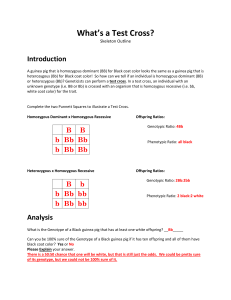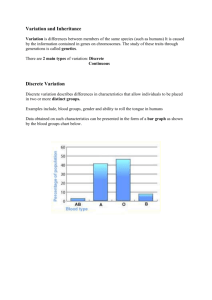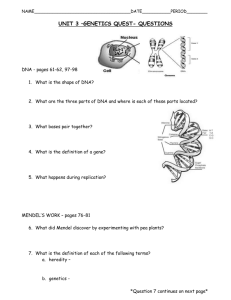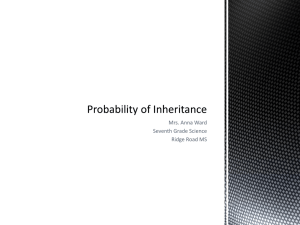Dragons are a curious type of creature. Amazingly, though, their
advertisement
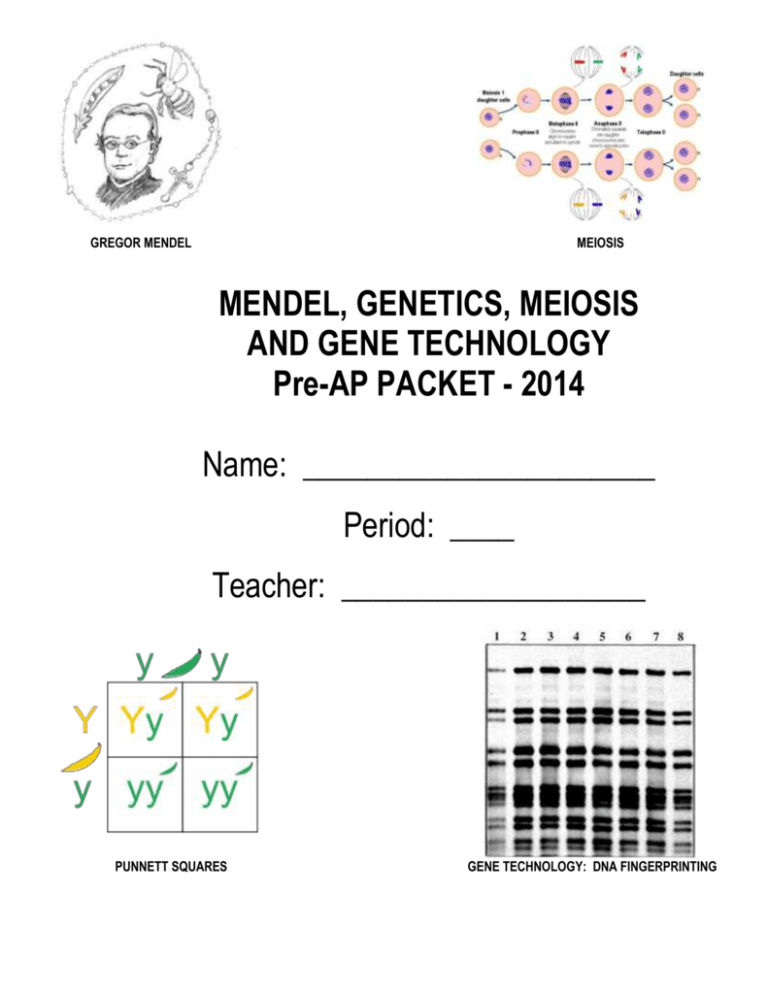
GREGOR MENDEL MEIOSIS MENDEL, GENETICS, MEIOSIS AND GENE TECHNOLOGY Pre-AP PACKET - 2014 Name: ______________________ Period: ____ Teacher: ___________________ PUNNETT SQUARES GENE TECHNOLOGY: DNA FINGERPRINTING STUDENT UNIT PLAN LEARNING TARGETS: MEIOSIS, GENETICS and GENE TECHNOLOGY VOCABULARY TERMS: Meiosis Genotype Homozygous Dominant Recessive Phenotype Purebred Hybrid Heterozygous Allele Chromosome Punnett Square Monohybrid Cross Dihybrid Cross offspring Co-Dominance Incomplete Dominance Sex-Linked traits Crossing Over Mendelian Genetics Law of Independence Law of Segregation Non-disjunction Homologous Genetic variability Sexual Reproduction Sex Cells (gametes) DNA Fingerprinting Genetic Modifications Karyotype Gregor Mendel Learning Targets: Assignments Stock Questions 1. I recognize the significance of meiosis to reproduction. Why is it important for the gametes (sex cells) to divide? How do Mitosis and Meiosis Compare? Contrast? What is the difference between an inherited and an acquired characteristic? 2. I can explain the difference between homozygous and heterozygous; dominant and recessive; and phenotype and genotype. 3. I can predict the possible outcomes of various genetic combinations when used in monohybrid and dihybrid crosses (Punnett Squares). 4. I can explain what a nondisjunction is and its affects. What is the only way a recessive trait can be expressed. Why is it important for the homologous chromosomes to separate during meiosis? 5. I can predict the outcomes of incomplete dominance, co-dominance and sex-linked punnett squares. 6. I can describe how gene technology such as DNA Fingerprinting, Gene Splicing and Karyotyping are used to study the genomes of organisms. 7. I can read and explain how DNA Fingerprinting (electrophoresis) works to give scientists information about an organism’s genome 8. I can explain how gene modifications are used to study and treat genetic disorders. 9. I can explain how gene modifications are used to study and treat genetic disorders. 10. I can interpret karyotypes to identify genetic disorders Why is DNA Fingerprinting important to scientists? How is a DNA Fingerprint made? Why is it important that genes can be manipulated? Page 2 Level of Understanding after discussion and assignments: or Mendel and Genetics Notes: Gregor Mendel ______________________________________________________________________________ ___________________________________________________________________________________________ ___________________________________________________________________________________________ ___________________________________________________________________________________________ ___________________________________________________________________________________________ GENETICS/HEREDITY/INHERITANCE: ________________________ _________________________________________________________ _________________________________________________________ _________________________________________________________ _________________________________________________________ __________________________________________________________ THE PRINCIPLE OF DOMINANCE: ___________________________ _________________________________________________________ Give an example of a dominant trait: _________________________________________________________ _________________________________________________________ _________________________________________________________ Give an example of a recessive trait: _________________________________________________________ _________________________________________________________ THE PRINCIPLE OF SEGREGATION: _______________________ _______________________________________________________ _______________________________________________________ Give an example of a gene: _______________________________________________________ Gene: _________________________________________________ Give an example of an allele: _______________________________________________________ _______________________________________________________ Give an example of Homozygous: Allele: _________________________________________________ _______________________________________________________ Give an example of Heterozygous: Homozygous: __________________________________________ Heterozygous: _________________________________________ Give an example of Genotype: Genotype: _____________________________________________ Phenotype: ____________________________________________ Page 3 Give an example of Phenotype: Mendel and Genetics Notes Continued………….. PRINCIPLE OF PROBABILITY: ___________________________ ______________________________________________________ ______________________________________________________ In your own words, what does probability mean? ________________________________ ________________________________ PUNNETT SQUARES: ___________________________________ Punnett Square (or Monohybrid Cross) _______________________________________________________ Cross: _______ X ________ _______________________________________________________ PRACTICE PROBLEMS: Cross a Heterozygous Tall (T) Pea Plant with a homozygous small (t) Pea Plant. Show all your work! Cross a Homozygous Green (G) plant with a yellow (g) plant. DIHYBRID CROSS: _____________________________________ Genotype %: _____________________ ______________________________________________________ Phenotype %: ____________________ ______________________________________________________ Cross: ______ X ______ Genotype %: _____________________ Phenotype %: ____________________ PRINCIPLE OF INDEPENDENT ASSORTMENT: _______________ ________________________________________________________ ________________________________________________________ ________________________________________________________ Page 4 SHOULD THIS DOG BE CALLED SPOT? Imagine this microscopic drama. A sperm cell from a male dog fuses with an egg cell from a female dog. Each dog’s gamete carries 39 chromosomes. The zygote that results from the fusion of the gametes contains 78 chromosomes – one set of 39 chromosomes from each parent. One pair of the zygote’s chromosomes is shown below. Chromosome from the female dog L T T A h Chromosome from the male dog l T l H a a Each chromosome of the homologous pair contains alleles for the same traits. But one chromosome may have a dominant allele and the other may have a recessive allele. Use the drawing above and the table below to answer the questions. TRAIT Hair length Hair Texture Hair Curliness Coat Pattern 1. Dominant Gene Short (L) Wiry (T) Curly (H) Spotted (A) Recessive Gene Long ( l ) Silky ( l ) Straight ( h ) Solid ( a ) Will the new puppy have a spotted coat? _________ Explain why or why not: ______________________________________________________________ __________________________________________________________________________________ 2. Does the female dog (mother) have a spotted coat? ______ Explain how you know this: ____________________________________________________________ ____________________________________________________________________________________ 3. Does the male dog (dad) have a spotted coat? _______ Explain how you know this: _____________________________________________________________ ____________________________________________________________________________________ Page 5 4. What will be the texture of the puppy’s coat? ________________________________________ 5. Will the texture of the puppy’s coat resemble that of either of its parents? ___________ Explain how you know this: _______________________________________________________ ______________________________________________________________________________ ______________________________________________________________________________ 6. Will the puppy have curly hair or straight hair? ________________________________________ 7. a. Does the female dog have curly hair? ____________________________________________ b. Does the male dog have curly hair? _____________________________________________ 8. a. Define the term heterozygous: ________________________________________________ __________________________________________________________________________ b. For which traits is the puppy heterozygous? _____________________________________ __________________________________________________________________________ 9. a. Define the term homozygous ______________________________________________________ ________________________________________________________________________________ b. For which traits is the puppy homozygous? __________________________________________ ________________________________________________________________________________ 10. Explain why you cannot completely describe the puppy’s parents even though you can accurately describe the puppy. ___________________________________________________________________________ ___________________________________________________________________________________ ___________________________________________________________________________________ Page 6 Dragons are a curious type of creature. Amazingly, though, their genetics is very similar to that of humans. Hagrid, the Gamekeeper at Hogwarts, wishes to develop a herd of dragons for his Care of Magical Creatures class. Unfortunately, he only has two dragons as of now. The purpose of this activity is to determine what kinds of dragons Hagrid will have in his herd when (and if) his two dragons decide to mate. Interestingly, dragons make good tools for the investigation of genetics and meiosis My Baby Dragon’s Genotypes and Phenotypes Trait Genotype (Symbols for Alleles) Neck size Body color Spikes? (on end of tail or not on end of tail) Eye color Number of toes Horn? (present or absent) Fire breathing? Belly color Color of spikes Freckles? Tail length Color of wings Gender Ear frills present or absent? Page 7 Phenotype (Appearance) MY BABY’S FIRST PICTURE Page 8 WHEN IN DOUBT PUNNETT!! BIOLOGY 1 In rabbits, the gene for black (B) fur is dominant over the gene for white fur (b). Write the genotype and phenotype for the following table. GENOTYPE PHENOTYPE Heterozygous Homozygous Dominant Homozygous Recessive 1. The pair of letters that represent the genes of an organism is called the __________. 2. The description of the trait by gene expression (such as black fur or white fur) is called the ______________. 3. A capital letter (B) represents the gene as ____________________________________________. 4. A lower case letter (b) represents the gene as ________________________________________. 5. Genes that are alike in an organism are called _______________________________________. 6. Genes that are different in an organism is called _____________________________________. Circle the correct answer: 7. Bb is (circle one) : homozygous or heterozygous? 8. BB is (circle one): homozygous or heterozygous? 9. bb is (circle one): homozygous or heterozygous? 10. B is (circle one): dominant or recessive? 11. b is (circle one): dominant or recessive? 12. Bb is the genotype or phenotype? 13. Black is the genotype or phenotype? 14. White is a genotype or phenotype? 15. BB is a genotype or a phenotype? 16. bb is a genotype or a phenotype? Page 9 DIRECTIONS: Work the following problems using the Punnett squares provided below and be sure to show ALL your work to include the genotype and phenotype results. 18. Cross a homozygous tall (A) plant homozygous short ( a ) plant. 19. Cross: ____________ X ______________ Cross a heterozygous blue (B) plant with a homozygous red (b) plant. Cross: ____________ X __________ Genotype %: ________ Genotype %: _______ Phenotype %: ________ Phenotype %: ______ _ 20. Cross two heterozygous smooth (H) plants (h will be rough) 21. Cross: __________ X ___________ 22. Cross a homozygous Blue plant with leaved a heterozygous Blue plant. Cross: __________ X __________ Genotype % _____ Genotype % Phenotype % _____ Phenotype % _____ Cross a heterozygous yellow (G) seeded plant with a green (g) seeded plant. 23. Cross: _______ X _________ Cross a homozygous smooth leaved plant (M) with a rough (m) leaved plant. Cross: _________ X _________ Genotype % ______ Genotype % _______ Phenotype % ______ Phenotype % ______ Page 10 MORE PUNNETT PRACTICE !!!!!! Here are some more Punnett Squares for practice. Remember your definitions for the following problems: _____ 1. Genes of an organism that are alike a. Dominant _____ 2. Covers a weaker gene b. Recessive _____ 3. An organism that has different genes c. Genotype _____ 4. The actual genetic make-up of an organism d. Phenotype _____ 5. The physical appearance of an organism e. Homozygous _____ 6. A weaker gene that can be covered. F. Heterozygous Punnett Practice: Assign capital letter G to be the DOMINANT gene and lowercase g as the recessive gene for every punnett square. REMEMBER: GG OR gg is Homozygous and Gg is Heterozygous. G is dominant and g is recessive. Green hair is DOMINANT over gold hair G will represent the dominant gene g will represent the recessive gene 1. Homozygous Dominant X Homozygous Dominant: _____________X___________ Genotype %: ________________ Phenotype %: _______________ Page 11 2. Homozygous Dominant X Homozygous Recessive: _________ X _________ Genotype %: ________________ Phenotype %: _______________ 3. Heterozygous X Heterozygous: ___________ X ____________ Genotype %: ________________ Phenotype %: _______________ 4. Heterozygous X Homozygous Recessive: ___________ X __________ Genotype %: ________________ Phenotype %: _______________ 5. Homozygous Recessive X Homozygous Recessive: __________ X __________ Genotype %: ________________ Phenotype %: _______________ Page 12 Use the chart to identify the genotypes of the following traits and to solve the following problem: Trait Body Shape Body Color Eye Shape Nose Style Dominant gene Squarepants (A) Yellow (B) Round ( R) Long (L) Recessive Gene Roundpants (a) Blue (b) Oval (r) Stubby (l) 6. Heterozygous round eyes, blue body _____________________________ 7. Hybrid (Heterozygous) eye shape, purebred (Homozygous) roundpants __________________________ 8. Purebred (Homozygous) roundpants, Hybrid (heterozygous) long nose _____________________ SpongeBob’s Aunt Betty, who is a roundpants, has a cute, stubby nose. She has finally found the sponge of her dreams and is ready to settle down. Her new boyfriend, Tommy, always comments on how adorable her nose is (he says it reminds him of his mother’s – awwww isn’t that sweet?) They wonder what the chances are that their children would have a stubby nose like Betty. Tommy is a purebred squarepants but is a hybrid for a long nose. 9. What is the genotype of Aunt Betty and Tommy? __________ x _________ Aunt Betty = roundpants, stubby nose Tommy = Purebred Squarepants, long nose Genotype ratio: ______________________________ ___________________________________________ Phenotype ratio: _____________________________ ____________________________________________ Page 13 Using the dihybrid cross to the right, answer the following questions: 1. What is the cross for this dihybrid? ___________ x ____________ 2. What are the chances of offspring being heterozygous for both traits? _________ 3. What are the chances of offspring being homozygous for long tails? __________ 4. What are the chances of the offspring being homozygous for being submissive and defeated? ____________ 5. What are the chances of the offspring being without tails? ___________ 6. What is the genotypic ratio of this dihybrid? __________________________________ 7. What is the phenotypic ratio of this dihybrid? _____________________________________ Using the diagram to the right, answer the following questions: 1. What 2 traits do you think are being crossed? ________________________________________ ________________________________________ 2. What is the genotypic ratio illustrated in this dihybrid cross? ____________________________________ __________________________________________ __________________________________________ 3. What is the phenotypic ratio illustrated in this dihybid cross? ____________________________________ __________________________________________ _________________________________________ Page 14 OTHER PATTERNS OF INHERITANCE OF GENES LAW OF INDEPENDENT ASSORTMENT states __________________________________________________________ _________________________________________________________________________________________________ Sex-Linked Traits: A trait that is determined by a gene on a _________ chromosome (usually the ___ chromosome). Examples of Sex Linked Traits: ______________________, __________________ & __________________________ Females must receive __________________________ in order to express the trait. Females with 1 affected X are called __________________. Males that receive _____________ from their mother expresses the trait. Practice: Cross a colorblind mother with a father who has normal vision. Give the expected phenotypic and genotypic ratios of the offspring. Key: _____________________________________________ Cross: __________ x __________ Genotypic Ratio: _________________________________ Phenotypic Ratio: ________________________________ Polygenetic Traits “___________________”; Many __________ are controlled by more than one gene; have a _____________________ for ________________. Example: _______________________________________ Multiple Allele Genes that have more than ____ alleles. For example: ________________ - there are _____ possible alleles for this gene. Practice: Cross a female who has Type A blood (AA) with a male who has Type O Blood (ii) Key: _____________________________________________ Cross: ____________ X ______________ Genotypic Ratio: ______________________ Phenotypic Ratio: _____________________ Page 15 INCOMPLETE DOMINANCE Neither allele has “______________” dominance over the other; _______________________________ is a _________ of the 2 homozygous phenotypes Ex: ____________________ R = red W = white RW = _________ Practice: Cross a red (R) snapdragon with a White (W) snapdragon. Give the genotypic and phenotypic ratios. Key: R = red flower W = white flower Cross: RR x WW Genotypic Ratio: __________________________________ Phenotypic Ratio: _________________________________ Practice: Cross a pink snapdragon with a red snapdragon. Give the expected phenotypic and genotypic ratios. Key: __________________________ Cross: _________________________ Genotypic Ratio: __________________________________ Phenotypic Ratio: _________________________________ CODOMINANCE Both alleles _____________ dominance and are always _______________ if present. Ex: _______________________ B = black feathers W = white feathers BW = ____________________ feathers Practice: Cross a black (B) chicken with a white (W) chicken. Give the genotypic and phenotypic ratios. Key: BB = black feathers WW= white feathers Cross: BB x WW Genotypic Ratio: __________________________________ Phenotypic Ratio: _________________________________ Practice: Cross two black and white feathered chickens. Give the expected phenotypic and genotypic ratios of the offspring. Key: ___________________________________ Cross: _______________________ Genotypic Ratio: __________________________________ Phenotypic Ratio: _________________________________ Page 16 PRACTICE WORKSHEET FOR OTHER PATTERNS OF INHERITANCE: SEX-LINKED PUNNETT SQUARES: CROSS: A man with normal vision marries and has children with a woman who is a carrier of the colorblindness allele. What percentage of their offspring would be colorblind? CROSS: ___________________ X ____________________ Genotype %: ________________________________________ Phenotype %: _______________________________________ CROSS: A normal blooded male marries and has children with a woman who is a carrier of the hemophilia allele. What percentage of their offspring will have hemophilia? CROSS: ___________________ x _________________________ Genotype %: ___________________________________________________ Phenotype %: __________________________________________________ CROSS: A colorblind male marries and has children with a woman who is a carrier of the colorblind allele. What percentage of their offspring will be carriers? CROSS: ___________________ x _________________________ Genotype %: __________________________________________ Phenotype %: __________________________________________ Page 17 INCOMPLETE DOMINANCE PUNNETT SQUARES: CROSS: In Andalusian fowls, Black individuals (B) and White individuals (W) are homozygous. Fill in the blanks below and do the punnett square. Be sure to show all of your work. A homozygous black bird is crossed with a homozygous white bird. The offspring produced are bluish-gray. Genotypes: Black bird = _______ White bird = ______ Offspring = _______ CROSS: What results if a black fowl is crossed with a bluish-gray fowl? Show all your work. Cross: _______ x _________ Genotype %: ______________________________________ Phenotype %: ______________________________________ SpongeBob and his pal Patrick love to go jellyfishing at Jellyfish Field. The fields are home to a special type of green jellyfish known as Goobers and only really great fishermen are lucky enough to catch some on every trip. Many of the jellyfish are yellow (YY) or Blue (BB) but some end up green. What would happen if SpongeBob and Patrick crossed two Goobers? Cross: _______ x ________ What % offspring would be yellow? ______ What % offspring would be blue? _______ What % offspring would be Goobers? ________ CO-DOMINANCE PUNNETT SQUARES: Brad Pitt is homozygous Type B blood while Angelina Jolie is Type o blood. What are the possible genotype and phenotype % of their offspring? Cross: ________ x ________ Genotype %: _____________________________ Phenotype %: ___________________________________________________ Page 18 MEIOSIS (CELL DIVISION OF GAMETES) MEIOSIS: _______________________________________________________________________ _________________________________________________________________________________ Meiosis only occurs in ______________________________________________________________ What are homologous chromosomes? ______________________________________ ________________________________________________________________________________ What is a Diploid Cell? __________________________________________________ _____________________________________________________________________ What is a Haploid Cell? __________________________________________________ ________________________________________________________________________________ 2 Distinct Divisions of Meiosis: ___________________________________________________ ________________________________________________________________________________ ________________________________________________________________________________ _____________________________________________________________________________ _____________________________________________________________________________ _______________ Page 19 Each chromosome pairs with its ______________________________ homologous chromosome to form a structure called a _______________________. There are 4 ______________________ in a tetrad. As homologous chromosomes pair up, they exchange ______________________ information in a process called _____________________________ over producing new combinations of alleles which account for ___________________________________ among species. Gamete Formation in Meosis: HUMAN SPERM + HUMAN EGG = FERTILIZTION WHICH RESULTS IN HUMAN ____________. Type of Cells Examples of Cells Number of Chromosomes Where in body found? # of times goes through Cytokinesis MITOSIS Somatic Skin, Blood, Heart (2n) All over the body Once MITOSIS VS. MEIOSIS: Page 20 MEIOSIS BIOTECHNOLOGY What is Biotechnology? the use of living systems and organisms to ___________________ or _______________________________. It can also be any technological application such as ________________, ___________________________________ (DNA fingerprinting) and ___________________ that uses biological systems and living organisms to ___________ or _____________ products or processes for specific use. • Artificial Selection: Earliest form of biotechnology that has been used in ________________ and _______________. Its purpose is to produce _____________________ traits. There are 2 types of artificial selection: 1. ____________________ 2. ____________________(aka hybridization) • Inbreeding: Crossing 2 organisms with ________________________. Purpose: __________________ desirable traits in the same line of organisms Risks: Can cause ________________ _____________ (rr) traits to be expressed such as deafness, blindness, joint deformations. • Outbreeding: Crossing 2 organisms from ___________________ species (genotypes). This is also known as “____________________”. It ____________ causes _______________ but can also be used to conserve ___________________________ species and increase _________________ and _____________ in plants and animals. Page 21 • Genetic Engineering: Technique(s) used to _______________ or _____________________ genes at the molecular level. • Many uses such as: determining ___________________, identifying a __________________ of a particular ____________ for a particular disorder, etc. One technique is _______________________________ used to make a pattern called a “DNA Fingerprint”. • DNA Fingerprinting: an __________________ of ______________ of _____ that have little or no known function in order to identify one individual from another. • Cloning: A process used to ________________ an organism that is an _________________________________________ of another. This means that every single bit of DNA is the same between the two (like identical twins). • Genetically Modified Foods: Also known as __________________ Plants, food that have been genetically engineered for many reasons such as faster _____________, _____________________ to pathogen and production of extra ____________________. • Gene Splicing: A process used to take ________________ genes from one organism and _____________ them into another organism. Page 22 DNA Fingerprinting http://www.pbs.org/wgbh/nova/education/body/create-dna-fingerprint.html What item was disturbed in Jimmy’s room? _________________________________________________________________ What DNA evidence was left behind at the crime scene to test? ___________________________________________________ What is electrophoresis? ________________________________________________________________________________________ _______________________________________________________________________________________ What charge does DNA have?_____________________ What charge is it attracted to?_________________ What size fragment moves easily through the agarose gel? ____________________ By moving the DNA band over the suspects, determine who committed the crime. ____________________ In what ways is it like actual fingerprinting and in what ways is it different? _________________________ _________________________________________________________________________________________ _______________________________________________________________________________________ Cloning an Organism htpp://learn.genetics.utah.edu/content/tech/cloning/clickandclone/ The Cloning of Mimi the mouse: Step 1: The somatic cell is a ______________ cell and are found in the layer of cells around the ____________ cell. Step 2: Removing the nucleus from the egg cell the egg is now an _______________________egg cell. Step 3: We will transfer the __________________cell nucleus into the ____________________egg cell. Step 4: Here you will begin simulated cell division also known as ________________________________________. Step 5: Cell division takes place here creating a ball of cells called a __________________. The embryo continues to increase in cell number and form various ___________________. A mouse pregnancy lasts __________ days. Step 6: You have created a ______________of Mimi and the pup’s color is ____________. Why? __________________ __________________________________________________________________________________________ Page 23 GENE TECHNOLOGY WORKSHEET: Build a corn plant gene that is resistant to insects. Corn Spliced Gene Corn Build a strawberry gene that is resistant to freezing temperatures. Strawberry Spliced Gene Strawberry A farmer decides to grow roses WITHOUT thorns. Create a thornless rose. Cut along this dotted line Create a new gene segment by cutting the organism DNA and gluing in the new gene. Organism Genes Corn: Color Yellow Insect Resistance Strawberry: Color Red Cold Resistance T Rose: Color Green Page 24 SELF QUIZ 1. Which of the following accurately identifies all the possible combinations of genes in the offspring of two parents who are heterozygous for the gene with a dominant form (R) and a recessive form (r). A. B. C. D. 2. The process of DNA fingerprinting allows scientists to study organisms by doing which of the following? A. B. C. D. 3. Ty, ty TY, ty TY, Ty, ty Ty, ty, tY, TY Which statement below best describes genetic modification? A. B. C. D. 6 It produces haploid gametes, with half the number of chromosomes. It creates organisms with better adaptability to the environment. It allows all types of cells to produce two sets of identical chromosomes. It produces up to eight haploid cells, each with 46 chromosomes. If a corn plant has a genotype of Ttyy, what are the possible genetic combinations that could result in a single grain of pollen from this plant? A. B. C. D. 5. Analyzing DNA left behind in the oily residue of fingerprints Making images of sequences of DNA from individual organisms Breaking open an individual's cells to release the DNA fragments Matching of base sequences in the DNA sample with that of finger cells Which statement best describes the significance of meiosis to sexual reproduction? A. B. C. D. 4. rr only RR only Rr and rr only RR, Rr, and rr only It is a method of identifying proteins of particular DNA sequences. It is the replacement of a set of chromosomes of an individual with another. It is a technique used to compare DNA sequences of one individual to another. It is the insertion of a gene from one organism into a host genome. In fruit flies, the gene for eye color is located on the X chromosome, and the red eye allele (R) is dominant over the white eye allele (r). A female fly with genotype XRXr is mated with a male fly with genotype XrY. Which statement below best describes the expected outcome of this cross? A. B. C. D. XrY = 0% XRY = 25% XrXr = 50% XRXR = 100% Page 25 7. In certain rose plants, white roses (W) and red roses (R) are incompletely dominant to one another. When a red rose is crossed with a white rose, a pink rose(RW) will result. What is the probability of producing more pink roses from two pink parents? A. B. C. D. 8. The gene for tallness (T) in a pea plant is dominant over the gene for shortness (t). The Punnett square below shows the cross between two tall pea plants (Tt). What is the phenotypic ratio of the offspring produced as a result of the cross? A. B. C. D. 9. DNA fingerprinting Gel electrophoresis Karyotyping Genetic modification During meiosis, genetic recombination results because – A. B. C. D. 11. 1:2:1 9:3:3:1 3:1 2:1 Nondisjunction is an error that occurs during meiosis when a gamete does not receive a copy of one chromosome. Which technique can be used to reveal this abnormality? A. B. C. D. 10. 0% 25% 50% 100% chromosomes assort independently, and crossing-over occurs genes from different species can freely mix together gene mutations occur more frequently than at other times cells divide only once, resulting in genetically identical cells What is the probability that a yellow (Y) and wrinkled pea (r) will appear from a cross of Yyrr x YyRr? A. B. C. D. 3/8 1/2 3/4 7/8 Page 26




